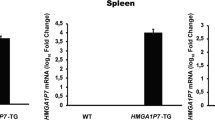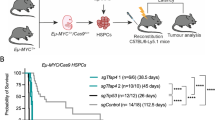Abstract
Transgenic mice bearing the cellular myc oncogene coupled to the immunoglobulin μ or κ enhancer frequently develop a fatal lymphoma within a few months of birth. Since the tumours represent both immature and mature B lymphocytes, constitutive c-myc expression appears to be highly leukaemogenic at several stages of B-cell maturation. These myc mice should aid study of lymphoma development, B-cell ontogeny and immunoglobulin regulation.
This is a preview of subscription content, access via your institution
Access options
Subscribe to this journal
Receive 51 print issues and online access
$199.00 per year
only $3.90 per issue
Buy this article
- Purchase on Springer Link
- Instant access to full article PDF
Prices may be subject to local taxes which are calculated during checkout
Similar content being viewed by others
References
Bishop, J. M. A. Rev. Biochem. 52, 301–354 (1983).
Varmus, H. E. A. Rev. Genet. 18, 553–612 (1984).
Duesberg, P. H. Science 228, 669–677 (1985).
Palmiter, R. D. & Brinster, R. L. Cell 41, 343–345 (1985).
Brinster, R. L. et al. Nature 306, 332–336 (1983).
Storb, U. et al. Nature 310, 238–241 (1984).
Grosschedl, R., Weaver, D., Baltimore, D. & Costantini, F. Cell 38, 647–658 (1984).
Rusconi, S. & Köhler, G. Nature 314, 330–334 (1985).
Brinster, R. L. et al. Cell 37, 367–379 (1984).
Palmiter, R. D., Chen, H. Y., Messing, A. & Brinster, R. L. Nature 316, 457–460 (1985).
Hanahan, D. Nature 315, 115–122 (1985).
Messing, A., Chen, H. Y., Palmiter, R. D. & Brinster, R. L. Nature 316, 461–463.
Stewart, T., Pattengale, P. & Leder, P. Cell 38, 627–637 (1984).
Hayward, W., Neel, B. G. & Astrin, S. Nature 290, 475–480 (1981).
Payne, G. S., Bishop, J. M., & Varmus, H. E. Nature 295, 209–214 (1982).
Corcoran, L. M., Adams, J. M., Dunn, A. R. & Cory, S. Cell 37, 113–122 (1984).
Sefton, G., Cuypers, H., Zijlstra, M., Melief, C. & Berns, A. EMBO J. 3, 3215–3222 (1984).
Leder, P. et al. Science 222, 765–771 (1983).
Klein, G. & Klein, E. Immun. Today 6, 208–215 (1985).
Cory, S. Adv. Cancer Res. (in the press).
Gillies, S. D., Morrison, S. L., Oi, V. T., Tonegawa, S. Cell 33, 717–728 (1983).
Banerji, J., Olson, L. & Schaffner, W. Cell 33, 729–740 (1983).
Neuberger, M.S. EMBO J. 2, 1373–1378 (1983).
Grosschedl, R. & Baltimore, D. Cell 41, 885–897 (1985).
Rabbitts, T. H., Hamlyn, P. & Baer, R. Nature 309, 592–597 (1984).
Corcoran, L. M., Cory, S. & Adams, J. M. Cell 40, 71–79 (1985).
Queen, C. & Baltimore, D. Cell 33, 741–748 (1983).
Picard, D. & Schaffner, W. Nature 307, 80–82 (1984).
Brinster, R. L., Chen, H. Y., Trumbauer, M. E., Yagle, M. K. & Palmiter, R. D. Proc. natn. Acad. sci. U.S.A. 82, 4438–4442 (1985).
Land, H., Parada, L. & Weinberg, R. Nature 304, 596–602 (1983).
Palmiter, R. D., Chen, H. Y. & Brinster, R. L. Cell 29, 701–710 (1982).
Palmiter, R. D., Norstedt, G., Gelinas, R. E., Hammer, R. E. & Brinster, R. L. Science 222, 809–814 (1983).
Downes, T. M., Lingrel, J. B., Chen, H. Y., Brinster, R. L. & Palmiter, R. D. EMBO J. 4, 1715–1723 (1985).
Abelson, H. T. & Rabstein, L. S. Cancer Res. 30, 2213–2222 (1970).
Kemp, D. J., Harris, A. W., Cory, S. & Adams, J. M. Proc. natn. Acad. sci U.S.A. 77, 2876–2880 (1980).
Kemp, D.J., Harris, A. W. & Adams, J.M. Proc. natn. Acad. sci. U.S.A. 77, 7400–7404 (1980).
Alt, F. W., Rosenberg, N., Enea, V., Siden, E. & Baltimore, D. Molec. cell. Biol. 2, 386–400 (1982).
Kemp, D. J., Wilson, A., Harris, A. W. & Shortman, K. Nature 286, 168–170 (1980).
Nelson, K. J., Haimovich, J. & Perry, R. P. Molec. cell. Biol. 3, 1317–1332 (1983).
Rogers, J. et al. Cell 20, 303–312 (1980).
Reth, M. G. & Alt, F. W. Nature 312, 418–423 (1984).
Van Ness, B. G. et al. Cell 27, 593–602 (1981).
Alt, F. W., Enea, V., Bothwell, A. L. M. & Baltimore, D. Cell 21, 1–12 (1980).
Lewis, S., Rosenberg, N., Alt, F. & Baltimore, D. Cell 30, 807–816 (1982).
Bernard, O., Cory, S., Gerondakis, S., Webb, E. & Adams, J. M. EMBO J. 2, 2375–2383 (1983).
Adams, J. M., Gerondakis, S., Webb, E., Corcoran, L. M. & Cory, S. Proc. natn. Acad. sci. U.S.A. 80, 1982–1986 (1983).
Kelley, K., Cochran, B. H., Stiles, C. D. & Leder, P. Cell 35, 603–610 (1983).
Nishikura, K. et al. Proc. natn. Acad. sci. U.S.A 80, 4822–4826 (1983).
Nishikura, K., Erikson, J., Ar-Rushdi, A., Huebner, K. & Croce, C. M. Proc. natn. Acad. sci. U.S.A. 82, 2900–2904 (1985).
Zaller, D. & Eckhardt, L. Proc. natn. Acad. sci. U.S.A. 82, 5088–5092 (1985).
Wanebo, H. J., Gallmeier, W. M., Boyse, E. A. & Old, L. J. Science 154, 901–903 (1966).
Glanville, N., Durnam, D. & Palmiter, R. D. Nature 292, 267–269 (1981).
Max, E., Maizel, J. & Leder, P. J. biol. Chem. 256, 5116–5120 (1981).
Gonda, T., Sheiness, D. & Bishop, J. M. Molec. cell. Biol. 2, 617–624 (1982).
Thomas, P. Proc. natn. Acad. sci. U.S.A. 77, 5201–5205 (1980).
Author information
Authors and Affiliations
Rights and permissions
About this article
Cite this article
Adams, J., Harris, A., Pinkert, C. et al. The c-myc oncogene driven by immunoglobulin enhancers induces lymphoid malignancy in transgenic mice. Nature 318, 533–538 (1985). https://doi.org/10.1038/318533a0
Received:
Accepted:
Published:
Issue Date:
DOI: https://doi.org/10.1038/318533a0
This article is cited by
-
PICH deficiency limits the progression of MYC-induced B-cell lymphoma
Blood Cancer Journal (2024)
-
Role of Rad18 in B cell activation and lymphomagenesis
Scientific Reports (2024)
-
Exploiting the fibroblast growth factor receptor-1 vulnerability to therapeutically restrict the MYC-EZH2-CDKN1C axis-driven proliferation in Mantle cell lymphoma
Leukemia (2023)
-
The anti-cancer agent APR-246 can activate several programmed cell death processes to kill malignant cells
Cell Death & Differentiation (2023)
-
Lymphoma cells lacking pro-apoptotic BAX are highly resistant to BH3-mimetics targeting pro-survival MCL-1 but retain sensitivity to conventional DNA-damaging drugs
Cell Death & Differentiation (2023)
Comments
By submitting a comment you agree to abide by our Terms and Community Guidelines. If you find something abusive or that does not comply with our terms or guidelines please flag it as inappropriate.



